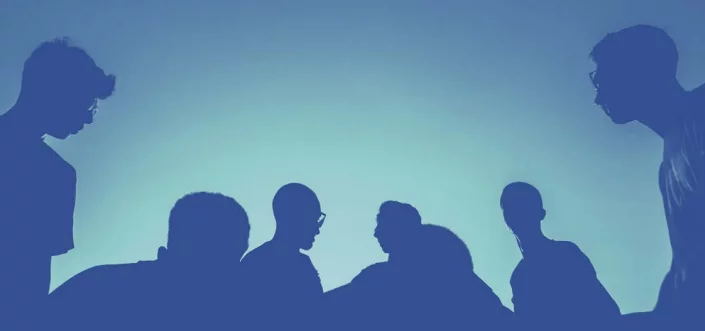ResearchMental Health
Male loneliness and isolation: What the data shows

Key takeaways
- Time spent alone has risen for both men and women over the past two decades, with similar rates of reported loneliness, emotional support, and close friendships.
- Around 70% of both men and women feel adequately supported socially and emotionally.
- Men are somewhat more likely to be socially isolated than women. They are more likely to say that they are “not meaningfully part of any group/community,” for example.
- Men and women socialize differently; women engage friends and family more often, while men engage in group activities.
- Overall, there appears to be much more of a class gap (as measured by education level) than a gender gap in loneliness and isolation.
Introduction
Since 2023, experts have described loneliness and social isolation in the United States as an epidemic. People are spending less time with friends and more time alone. Many journalists have focused on men in particular, citing findings that young men in America are among the loneliest and that there are five times as many men who say they have no close friends as there were in 1990.
Here we examine the most recent evidence on loneliness and friendship, as well as other data that captures aspects of social isolation, emotional support, friendship, and participation in different social activities. We also provide new analyses by gender of existing datasets, including the Household Trends and Outlook Pulse survey.
We find that people are indeed spending more time alone than they were 20 years ago, but the trend has been similar for both men and women. On broad measures such as overall loneliness, satisfaction with emotional support, number of close friends, and time spent alone, men and women look similar. This is notable given that increasing loneliness and isolation are linked to a range of serious outcomes—men, for example, die by suicide at roughly four times the rate of women, and suicide is often linked to social disconnection.
However, these similarities can hide important differences. Men overall are more likely to report specific feelings of disconnection, such as not belonging to any group or community or feeling their place in the world is not relevant. In older age, they also have higher odds of being socially isolated. By contrast, young men often report lower loneliness than young women, suggesting patterns vary by life stage. Finally, the large friendship gaps by education level suggest it plays a bigger role than gender in shaping social isolation. We believe that the class gap deserves more attention than the gender gap.
Loneliness and aloneness
Both men and women are spending more time alone than they were even twenty years ago, with parallel trends for men and women, according to data from the American Time Use Survey shown in figure 1. As writers like Derek Thompson have pointed out, this increasing isolation can lead to a host of social ills, including increased polarization and declining civic engagement, regardless of self-reported loneliness.
Figure 1
Because loneliness is a subjective feeling of disconnection, someone can feel lonely even if they’re surrounded by others, and they can feel fine even if they’re by themselves. It arises from a perceived gap between the number or quality of relationships people want and those they actually have.
Figure 2
In figure 2, we show several recent surveys with nationally representative samples that measure adult loneliness by gender. While the wording of specific questions differs, all but one show men and women within roughly a percentage point of one another. The largest survey—the U.S. Census’ Household Trends and Outlook Pulse Survey with a sample size of about 6,700 adults—shows no gap.
One exception to this overall similarity is among youth, as figure 3 shows. Gallup found recently that a quarter of men aged 15-34 report feeling lonely compared to 18% of women. Other surveys point in the other direction, and the difference is especially stark among teens. In 2023, 25% of American 8th and 10th grade boys said they often feel lonely. But for girls it was 44%.
Figure 3
Data noteDifferences in polling may be due to differences in timing, question wording, or prompt wording. For example, respondents to the Gallup poll were given the choice between “Yes” and “No.”
Respondents to the Making Caring Common study chose between “Never”, “Occasionally”, “Frequently”, and “Almost all of the time or all of the time”.
The Household Trends and Outlook Pulse Survey respondents chose from “Always, “Usually,” “Sometimes,” “Rarely,” and “Never.”
While the mixed and somewhat noisy evidence makes strong conclusions difficult, it does suggest that if anything, it is young women that report feeling particularly lonely right now.
Friendships
In recent years, the idea of a “friendship recession” has gained traction in both media and academic circles (including a video from our own president, Richard Reeves, with that very title). In 2021, the American Perspectives Survey found that 15% of men had no close friends compared to 10% of women—an increase from 3% and 2%, respectively, in 1990.
Figure 4
But as shown in figure 4, more recent polling by Pew in 2023, based on additional analysis they provided to us, finds a minimal gap, with 9% of men and 8% of women reporting no close friends. They also found that men and women both report having about 5 close friends.
Figure 5
The American Perspectives Survey also found that men are less satisfied than women with the number of friends they have. However, a 2023 survey by the Public Religion Research Institute found that men and women show about equal levels of satisfaction with the number of close friends that they have. Young men were actually more satisfied than young women, while differences declined at older ages.
Figure 6
And while there is evidence to suggest that male support networks are smaller and less resilient, men and women participating in the 2025 Household Trends and Outlook Pulse Survey report similar levels of social and emotional support—just under 70%.
Gender differences on some dimensions of isolation
While men and women appear similar on high-level measures such as time spent alone, overall loneliness, satisfaction with emotional support, and number of close friends, those broad metrics can gloss over meaningful differences.
The Making Caring Common survey found that while men and women gave similar answers to general loneliness questions, men were more likely to report feelings of disconnection or irrelevance. They were more likely to say that they were “not meaningfully part of any group/community,” for example, or that their “place in the world doesn’t feel relevant,” and that they “don’t feel like a part of the country.” These findings could reflect genuine differences, but they might also arise from how men interpret loneliness questions or from variations in survey wording; further research is needed to test their consistency.
Figure 7
These survey-based perceptions tell one part of the story. Other research using broader social isolation indices which capture the size and frequency of one’s contacts, participation in community life, and relationship status also finds a modest male disadvantage. A national study of adults found that men were slightly more isolated than women at every age, with gaps largest among those who were never married. Among adults 65 and older, men had more than double the odds of being socially isolated compared with women.
These patterns suggest that while the amount of time alone and self-reported loneliness may not differ much by gender, the structure of social connections often does. Men are more likely to have smaller, less diverse networks and to lack certain forms of community participation. Our analysis of the Household Pulse Survey shows that while a majority of both men (68%) and women (69%) say they are getting their social and emotional needs met, how they meet those needs differs somewhat, as figure 8 shows.
Figure 8
For both men and women, spouses are a primary source of support (85% and 72%, respectively). Later marriages therefore potentially change the social landscape for everyone. But for men, these shifts can have a sharper impact because they may rely more heavily on romantic relationships for affection, personal support, and to facilitate friendship. This is reflected in the fact that married men and men with children spend more time socializing than single men, that married men are more likely than married women to turn first to their spouse for personal problems, and that single men are far less likely than single women to receive physical affection.
Because men lean more on their partners for connection, they may have fewer alternative sources of support when they are single. Our analysis of the 2021 American Perspectives Survey shows that men are likely to get support from their parents (56% for men vs 50% for women) and less likely to get it from friends (15% vs 17%). When men do connect, it is often through group activities rather than one-on-one relationships. While these differences are modest, men are more likely to connect socially through clubs and organizations and less likely to get together with friends or neighbors.
The class gap in friendship
Class seems to be a bigger factor than gender when it comes to friendship networks. Since 1990, educational attainment has become associated with a starker difference in social networks than gender, according to research from Dan Cox and Sam Pressler. Those without a college degree are about twice as likely as college graduates to have no close friends, as figure 9 shows.
Figure 9
Americans with less education, not least men, are less likely to have strong social connections and support, so as men struggle educationally, they may also struggle socially.
Conclusion
Americans now spend more time alone than they did two decades ago, but the retreat from social life looks similar for men and women. Survey data likewise show that the sexes report similar levels of loneliness, comparable numbers of close friends, and equivalent perceptions of emotional support.
Yet averages can conceal as much as they reveal. Greater risks may cluster among certain subgroups, such as younger women or older men. Men and women may also define and disclose loneliness differently, and gender norms continue to shape how men build and sustain friendships.
Less social contact matters, even when people don’t necessarily feel lonelier: falling marriage rates, rising screen time, and the erosion of community “third places” have all chipped away at the elements of daily life that once fostered in-person connection. These losses can weaken our ability to relate to others, increase polarization, and reduce the kinds of civic participation that are so important for democracy.
Taken together, the evidence suggests that the loneliness epidemic is not a blanket crisis for men in particular. Some men are struggling more than women, but other groups of women are also potentially at risk. A college degree may be more important in understanding differences in loneliness and social isolation than gender.
Getting a better understanding of the true nature of social isolation helps to illuminate many of the challenges faced by boys and men. Men are four times more likely to die by suicide than women, and the risk has risen in recent years among young men, but differences in self-reported loneliness do not appear to explain that gap. So we need to look elsewhere.
The trends described above underline the need to create spaces and opportunities for meaningful connection for both men and women, and above all for those struggling most in our society.
The authors thank DJ Windsor for his contributions to this research brief.
Think we missed something? We welcome information on additional studies or surveys examining gender differences in social connection and well-being. Send us a note at [email protected] with your feedback.
Subscribe to our newsletter
Get the latest developments on the trends and issues facing boys and men.
Related Research

Mental Health
Data Spotlight: Suicide deaths among young men
Male suicide rates are rising—especially among young men. Explore key trends, data, and years of life lost from 2001–2023.

Mental Health
Male suicide trends by class and occupation
Men without college degrees face double the suicide risk—especially in high-risk jobs like construction and repair.

Mental Health
The challenges facing boys and men in Greater Boston
A new report from Boston Indicators and the American Institute for Boys and Men examines the challenges facing boys and men in Boston, particularly in education, health, and employment.